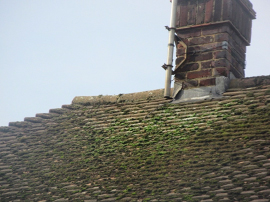When is a Green Roof Not a Green Roof?
Daniel Bailey BSc(Hons) MRICS | Senior Chartered Surveyor
January 28, 2021

When there is too much vegetation growth on your roof.
A true green roof has a substrate to support vegetation growth and will need some maintenance depending on the type of plants used. The drainage and structure are designed to allow for the escape of water whilst functioning as a modern roof with insulation and impervious membranes.
Moss and vegetation growth on a conventional pitched roof may have unintended consequences and can cause harm to the building, and its fabric, in a number of ways – it doesn’t mean you’re more environmentally friendly!
Moss and vegetation growth is fairly inoffensive, and it happens over a long period of time. Some may think it even adds character to a property, which perhaps it does to an extent, but too much and you may find some issues occurring.
Did you know…
- Moss holds significantly more water and will contribute to degrading of the roof covering over time.
- Moss falls into gutters causing blockages of the drainage system and overspilling, which leads to water penetration through the structure.
- Moss can restrict the air flow through a roof designed to breathe and cause condensation which can lead to structural defects.
- Moss can restrict the view of the roof, concealing other defects.
When is this an issue?

It takes years for moss and vegetation growth to become prevalent, which is fairly innocuous and out of the eye line, so many people don’t consider it – or unwittingly overlook it.
Somewhere in the region of 10-25% vegetation growth on a roof pitch can begin to cause unwanted issues, although a sensible view should be taken if concentrated in one particular area of the roof pitch.
What can you do?
The roof and high-level elements, such as gutters, chimneys, and flashings, should be reviewed as part of normal property maintenance. Every 3 – 5 years is usually sufficient. Clearly, the rate of vegetation growth depends on conditions and circumstances.
Cleaning the roof should not be carried out by a high-pressure wash (i.e., jet washing) as it can cause other defects. For example, it may actually strip tiles, reducing their effectiveness and making them more porous.
Chemical cleaners can be used but with caution so as not to harm the roof covering. You should always check the roofing materials and manufacturer’s suggested guidance on cleaning.
Scraping the roof manually is more laborious but much better for your building fabric. Alternatively, a low-pressure long hose or brush can be effective, if used correctly.
You could even consider a copper strip fixed to the ridge of a pitched roof which helps to significantly reduce the growth of moss and algae.
Health and Safety
You, or a contractor, should allow for the appropriate access for the roof, which may include scaffold or towers to safely work at height, and should be carefully considered in line with HSE guidelines.
Final thoughts
Moss and vegetation growth is unlikely to be an immediate problem, unless you have neglected it for years – you’ll know when you look up (binoculars are always good!). By undertaking this relatively simple task, you can save other defects from occurring, and it is generally inexpensive. It certainly will be more expensive to fix other defects as a consequence of not doing so. It may be infrequent, but it doesn’t mean never.
To get in touch with Daniel or our team, send him an email or get in contact.
Call or email us at:
- 020 3102 7701 (London)
- 01277 223594 (Shenfield, Brentwood, Essex)
- info@howecharteredsurveyors.co.uk